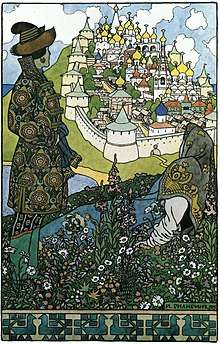Buyan

In the Dove Book and other medieval Russian books, Buyan (Russian: Буя́н, sometimes transliterated as Bujan[1]) is described as a mysterious island in the ocean with the ability to appear and disappear using tides. Three brothers—Northern, Western, and Eastern Winds—live there, and also the Zoryas, solar goddesses who are servants or daughters of the solar god Dazhbog.[2]
It figures prominently in many famous myths; Koschei the Deathless keeps his soul or immortality hidden there, secreted inside a needle placed inside an egg in the mystical oak-tree; other legends call the island the source of all weather, created there and sent forth into the world by the god Perun. It is also mentioned in The Tale of Tsar Saltan, of His Son the Renowned and Mighty Bogatyr Prince Gvidon Saltanovich, and of the Beautiful Princess-Swan (an opera by Nikolai Rimsky-Korsakov, set partially in Tmutarakan and Buyan's magical city of Ledenets (Russian: Леденец, "sugary")) and many other Slavic folktales. Furthermore, it also has the mythical stone with healing and magic powers, known as the alatyr' (Russian: Алатырь), which is guarded by the bird Gagana and Garafena the serpent.
Some scholars interpret Buyan as a sort of Proto-Indo-European Otherworld (see Fortunate Islands). Others assert that Buyan is actually a Slavic name for some real island, most likely Rügen.[3]
Influence
- The Buyan-class corvette is a class of corvettes used by the Russian Navy.
- Buyan. an uninhabited island on the northern parts of the Severnaya Zemlya Archipelago off the northern coast of Russia.
- Buyan Insula, an insula (island) within Ligeia Mare on Saturn's moon Titan.
- Buyan, a Russian-cuisine restaurant in Singapore that is currently being closed.[4]
- Buyan is mentioned in Catherynne M. Valente's novel Deathless as the "Country of Life", a grotesque island nation ruled by Koschei where everything (even the flesh-like buildings) is organic and alive. It is also mentioned in another work by Catherine M. Valente, The Girl Who Circumnavigated Fairyland in a Ship of Her Own Making, in which the Marquess of Fairyland has conducted a peace treaty with the island country.
See also
Notes
- ↑ Anton Dietrich, Russian Popular Tales, 1857 (Google eBook) p.23
- ↑ Dixon-Kennedy, Mike (1998). Encyclopedia of Russian and Slavic myth and legend. ABC-CLIO. p. 48. ISBN 978-1-57607-130-4.
- ↑ http://www.google.com/search?tbs=bks%3A1&tbo=1&q=buyan+island+rugen&btnG=Search+Books
- ↑